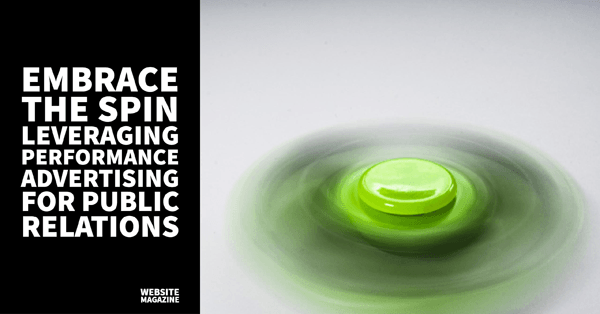Embrace the Spin: Leveraging Performance Advertising for Public Relations

The approach works, particularly when it is coupled with retargeting initiatives, but marketing on this channel should not be limited to an objective such as "sales" alone. The savviest brands today are able to take their performance advertising campaigns to another level entirely by aligning these efforts to public relations initiatives.

Public relations initiatives often have goals that can make a great deal of sense in the context of business operations. Although they have historically been somewhat difficult to measure (at least accurately) building awareness and developing influence, managing reputation and delivering thought leadership are some of the most common aims.
Improving upon these "goals," in a perfect world, would lead not only to increased mindshare, but also increased engagement, and with any luck, increased sales too. These specific goals and ultimately the result of achieving them are not all that different from those for digital marketing initiatives in general. Public relations, however, tends to focus on current perception, whereas digital marketing in general is often a more timeless, measured approach to presenting a brand and positioning it within the market.
Think of the two practices as related, with similar aims and objectives, but with a different path required to achieve success. How does performance advertising influence the success of public relations initiatives?
Keep in mind that the aim of a good PR campaign is to control and manage an audience's perception around some topic. Since most consumers search the Web (an intent-based search most often) it is possible for a savvy PR team aligned with a performance advertising group to identify issues of importance to the brand, establish rules to counter arguments against that brand, and develop a plan to change or influence the opinion of existing and prospective customers.
Say for example that a news outlet (or even a blogger) wrote an unflattering article about a company. In the past, public relations professionals might have engaged in practices like writing a letter to the editor or the writer, issuing their own press release and/or demanding a correction. Times have changed of course and those PR professionals skilled in performance advertising (and retargeting) know that acting quickly and targeting those that have expressed an opinion on a certain topic is the surest way to change the tide of public opinion.
The brand/company could buy performance-based ads from Google or Bing, engage in social advertising on Facebook or Twitter, perhaps even target specific sites through an ad exchange to flood websites where not only those that publish material counter to the brand's message congregate but also audiences that may have been influenced.
Targeting specific keywords is something else that PR-minded performance advertisers must keep in mind. If brands really want to make an impact, they should make sure to have coverage on sensitive terms including "reviews" and "complaints," as well as the name of the company and those who published the unflattering material (i.e., the writer and the news outlet or company that employs them).
The key to success with this strategy is two-fold. First, it is vital that a strong media monitoring platform be in use - leveraging performance advertising days or weeks late is a waste of time as opinions have been established and consumers have moved on. If brands are not able to engage quickly/immediately, time is better spent on another project. Second, performance advertising for the purpose of PR requires/demands an absolute flood of messaging; if it is not overwhelming and drawing mindshare away from the opposing message it is not doing its job and again is a waste of time and resources.
It is time for public relations departments and agencies to embrace the spin, employing performance advertising to unleash the full potential of their message when and where it is most necessary.
Creative PR Advice
Discover non-traditional ways to get media coverage at wsm.co/gotmedia.







